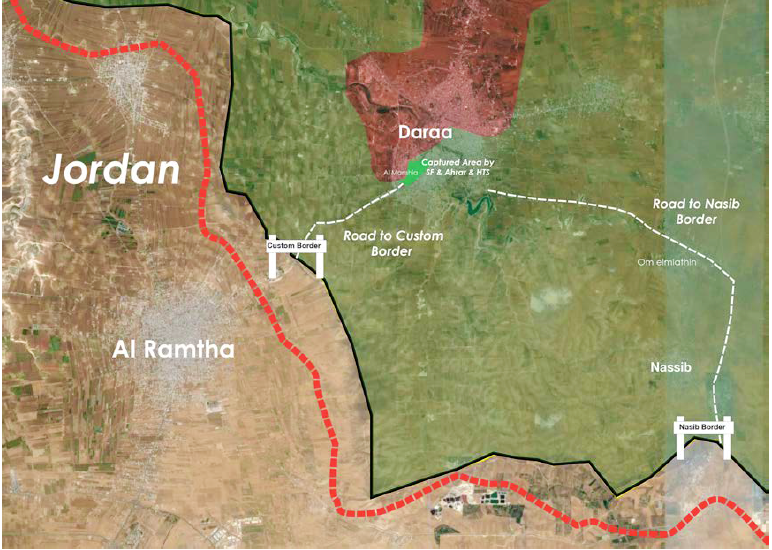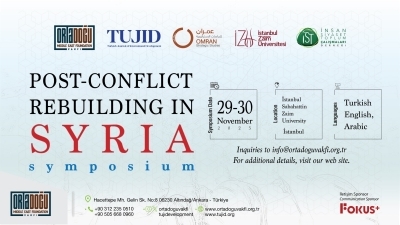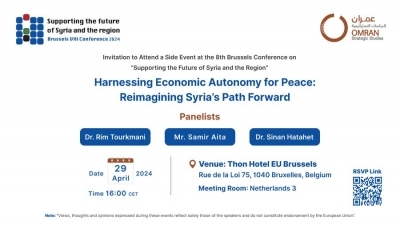Papers
Analysis: The Battlefield in Syria’s Southernmost City, Daraa
In recent weeks Daraa has witnessed the most intense clashes and aerial bombardments it has seen for years. Despite the plan for “de-escalation zones,” civilians in the city are likely to becaught in the newest battlefield for foreign power proxies and the warring Syrian sides.
ISTANBUL– When the Syrian government announced a 48-hour cessation of hostilities in Daraa on Saturday, some residents of the southern city were skeptical.
The brief pause in fighting, which ended on Tuesday as the Syrian army and its allied forces resumed their operation, came after two weeks of some of the most intense aerial bombardments and clashes the city has seen since 2015. Some saw the pause in fighting as a victory for the rebels who control the city and who have been resisting a government advance in the area since February. Others, however, were worried that the temporary halt was a cover for pro-government forces to bring in reinforcements.
The truce was announced just as the dates were set for the next round of United Nations-led peace talks in Geneva (July 10) and Russia-led negotiations in Astana (July 4–5). In theory, it sounded promising. Syrian state-run media said the purpose of the truce was “to back the national reconciliation efforts.” The area is part of Russia’s proposed “de-escalation zones,” where a ceasefire has, in theory, been in effect since last month, though it has not been enforced.
In fact, in recent months the area has become the newest battleground for fighting between rebel and pro-regime forces – and the various foreign powers with different strategic interests in the south. Aerial bombardment and ground clashes between opposition and pro-government forces are continuing in Daraa city.

Map of control for the fourth proposed “de-escalation zone” in Syria’s southern provinces. (Nawar Oliver)
“Moving forward, the bombing is only going to increase, and there will be no reconciliation,” a Syrian military source told the nonprofit journalism organization Syria Direct. “Give it a month, and this will all be taken care of.”
With so many parties involved, a lasting ceasefire in the area is an unlikely option, and despite the international community gearing up for yet another round of discussions aimed at stemming the ongoing violence and destabilizing the actions of warring parties, civilians in Daraa continue to suffer.
Recent Fighting
Pro-government forces have carried out roughly 2,000 air raids, including the use of barrel bombs, missiles and artillery shells, on Daraa city in recent months, according to the Syrian Observatory for Human Rights, a United Kingdom-based monitoring group. In the two weeks before the temporary ceasefire, pro-regime forces allegedly carried out 645 barrel-bomb attacks, 199 airstrikes, 645 mortar attacks and 91 napalm rocket attacks, according to the volunteer group Syria Civil Defence.
During this time at least 88 civilians, including 18 children and seven women, were reportedly killed by pro-regime forces. Twelve people were killed in an airstrike that hit a school housing IDPs, Muhammad Asakra, a citizen journalist based in Daraa city, told Syria Deeply. A government missile also hit the civil defense center in Daraa last week, rendering the building and one ambulance inoperable, according to the Syrian Network for Human Rights.
The increase in attacks preceded a major ground offensive in the city by the Syrian army and Iran-backed Shia militias. On June 4, pro-government reinforcements, including Lebanese Hezbollah and Shiite Iraqi militias and the army’s elite 4th Armored Division, were deployed in what rebels said was a move to seize the city and control Syria’s border with Jordan.
Pro-government forces were attempting to advance on the Daraa camp neighborhood to outflank the opposition, which had recently seized roughly 90 percent of the strategic al-Manshia district, Abo Muhammad Daraa, the spokesperson for rebel league Ahrar Horan, told Syria Deeply.
Fighting broke out in February when some Southern Front rebel factions, with members of Ahrar al-Sham and the al-Qaida-linked Hayat Tahrir al-Sham, launched the “Death Over Humiliation,” offensive against government forces in Daraa city, aimed at preventing the regime from capturing the border crossing with Jordan. On February 17, opposition fighters captured most of al-Manshia district and part of the highway leading to a crossing, postponing any regime attempts to reopen it.

Map showing the location of the February battle between rebels and pro-government forces to capture the border crossing with Jordan. (Nawar Oliver)
The partial truce came only after “repeated” failed attempts to seize the city, Major Issam al Rayes, spokesman for the Southern Front coalition of the Free Syrian Army (FSA), told Reuters. “The regime’s forces have stopped their military operations after big losses in equipment and men since the start of their campaign over a month ago,” he added.
According to a statement from the rebel military operations room known as al-Bunyan al-Marsous, at least 40 members of pro-regime forces were killed in recent clashes in Daraa, including high-ranking officers, such as Ahmad Fayez Tajo, who directed fighting in Zabadani city and Darayya district. Senior Iranian military adviser Haydar Jalilond was also killed in fighting in Daraa, according to the Iranian Nasim news agency.
Foreign Interests in Daraa
The Syrian government is not the only side fighting in Daraa with foreign allies. Jordan, which shares a 235-mile (375km) border with Syria, and its allies have maintained relations with rebels to deter fighting and keep the border region relatively free of hostilities. As a result, until February, Daraa had largely been considered a de facto safe zone – despite intermittent Syrian airstrikes.
The southern provinces are largely under the control of Syria’s armed opposition, comprising roughly 40 Free Syrian Army-linked factions operating under the Southern Front umbrella. The Southern Front has received varying degrees of training and funding from countries in the joint Military Operations Center (MOC) between Western and Gulf states based in Amman. This has enabled Jordan to exert control, with tacit consent from the U.S., Israel and Saudi Arabia, over rebel factions near the Israeli-controlled Golan Heights, southern Daraa province and the Yarmouk Valley.
Until February, the MOC had also been able to regulate the majority of activities between Southern Front factions and the Syrian regime. For example, in August 2016, the MOC reportedly offered Southern Front rebels monthly salaries if they refrained from an offensive against the government-controlled town of Sheikh Miskeen. This is just one instance of how Jordan had managed to keep a relative level of calm in the south before February.
Table showing the change in percentage of control of the different groups in southern Syria before and after the recent offensives. (Nawar Oliver)
When fighting broke out in February, the Jordanian government’s initial reaction was to close 55 miles (90km) of its border with Daraa and Quneitra, denying entry to everyone, including injured civilians. The MOC responded by attempting to persuade the Southern Front factions to stop the battle or halt their participation – signaling that Jordan did not consent to the fighting.
One source close to the situation, who requested anonymity for security reasons, suggested the battle was not a rogue move by the rebel groups, but rather an American plan to deter Syrian government- and Iran-backed pro-government forces from taking control of the border crossing with Jordan so close to its ally Israel. The U.S., Jordan, the Gulf States and Israel, on varying levels, oppose a strong Iranian presence on the southern borders – one of the main obstacles for foreign cooperation in a southern safe area.
‘Act for Daraa’
Daraa was not always a hub for foreign interests. The city, the homeland’s shield, was considered the spark that ignited the uprising against President Bashar al-Assad’s government in 2011.
The relative calm in Syria’s south in recent years has largely kept Daraa out of international headlines, but six years on residents and activists in the city are once again mobilizing to try to put an end to violence against civilians.
They started the “Act for Daraa” social media campaign on June 12 to raise awareness of the situation in the southern city. Using the hashtag #ActForDaraa, activists share photos, videos and reports of attacks in Daraa on various social media platforms. Some have also organized various sit-ins and demonstrations, and social media users around the world have posted pictures of themselves holding signs in support of the campaign.
Written by Housen Akoush, Nawar Oliver
Published In The syria deeply, 23 june 2017,
TRT World Interview with Ammar Kahf about on the latest in Aleppo
Dr. Ammar Kahf Talks about on the latest in Aleppo
TRT World - Interview with Dr. Ammar Kahf on Ceasefires in Syria
Dr. Ammar Kahf Talks About Ceasefires Syria
TRT World - Interview with Dr. Sinan Hatahet on the Current Status of the Cessation of Hositilities
Dr. Sinan Hatahet talks about the ongoing Cessation of Hostilities
TRT World - Interview with Dr. Sinan Hatahet on Cessation of Hostilities and Truces I Syria
Dr. Sinan Hatahet explains the difference between the Cessation of Hostilities and Truces in Syria
TRT World - Interview with Dr. Sinan Hatahet on a Political Solution in Syria
Dr. Sinan Hatahet Talks About the Sieges in Syria and the Opposition in Geneva
TRT World - Interview with Dr. Ammar Kahf on Russian Airstrikes in Syria
Dr. Ammar Kahf from Omran for Strategic Studies discusses Russia's Airstrikes on Hospitals and Civilians in Syria
TRT World - Interview with Dr. Sinan Hatahet on a Political Solution in Syria
Dr. Sinan Hatahet Talks About De Mistura, Zahran Alloush's Death and the Geneva Talks.
On the US-Russian Agreement on Cessation of Hostilities in Syria
Abstract: The statement on the cessation of hostilities in Syria released on February 22, 2016 following meetings between Kerry and Lavrov indicate the continuance of a joint US-Russian policy to push for a political process that excludes all “rebel” parties. This proposition reinforces new rules to push forward a political transition in Syria devoid of any political or legal guarantees that would end an era of state terrorism. The statement further entrenches the Russians in the Syrian file by graduating them from an ally of the regime to an internationally sanctioned sponsor of the political process and ultimately an overseer of the ceasefire with rights to strike “other groups” not specified in the agreement
Overview of the Statement
• Enhancing the position of Russian leadership in setting the conditions for a final settlement in Syria: the statement issued by the ISSG Ceasefire Task Force, established by the Munich Communique in February 11, 2016, led by the US and Russia, indicates the complete delegation of executable details of the final settlement from Washington to Moscow. Kerry has been committed to the Russian vision which has been repeatedly revealed in Lavrov’s public statements since the Vienna meetings last year. In turn, Russia is given a free hand to target any opponent to its proposal under the pretext of the fight against terrorism while at the same time ensuring the safety and security of all other groups not designated as terrorist organizations. This premise is evident in the exclusion of all groups who do not express commitment to the cessation of hostilities in addition to excluding ISIS and Jabhat al-Nusra and any other group designated by the UN Security Council as terrorist groups in Syria.
• Presenting the Syrian regime military as the only legitimate force of the Syrian state: the statement reiterated the legitimacy of the Syrian regime forces and militias as “the Armed Forces of the Syrian Arab Republic”. It further grants the Syrian Armed Forces exclusive rights to fight terrorism and Syrian opposition revolutionary forces. According to the statement, the regime forces become the guarantors of establishing peace and security in Syria. Meanwhile, all other Syrian forces; including the national moderate opposition, the Syrian democratic forces and the YPG units, are not allowed to fight ISIS or other groups designated as terrorists without authorization from the Syrian regime. Furthermore, the Syrian regime, with international support, is thus allowed classify the national moderate opposition forces as opponents of the regime’s state in the case they reject the cessation of hostilities, and therefore target and attack these forces without any legal or political deterrents.
• Managing exceptions within the agreement and maintaining the fluidity of the military situation: As a whole, the exceptions in this statement and previous UN resolutions maintain the fluidity of the military situation in Syria to the advantage of the regime and its allies. The agreement also excludes from the political process in Syria all of ISIS, Jabhat al-Nusra and other groups to be identified later on by the UN Security Council. The statement considers the national forces that reject the agreement as legitimate targets for the international coalition, Russia and regime forces. In contrast, the statement does not exclude from ceasefire arrangements any of the Iran-supported foreign militia. Instead, it considers them as legitimate groups because they fight along the “Syrian Armed Forces”. The national opposition forces are thus forced to stop all of their military actions against regime forces and its allies without exception and no matter the circumstance.
• Seperating ceasefire from negotiations, thereby abolishing the Political Solution: UN Security Council Resolution No. 2254 closely links a nationwide ceasefire with taking real steps towards a transitional process. The draft statement, however, does not maintain any such links and overlooks any of the preconditions to engage in tangible political progress. The statement concludes with a demand that all parties commit to the release of detainees without deeming it a prerequisite for engaging in the political process or a ceasefire. Furthermore, urging all parties to allow easy access for humanitarian assistance is basically the same as the implementation of Security Council Resolutions No. 2139 and 2165 – something the international community has failed to hold the regime accountable for since the passing of these resolutions. Moreover, efforts to force the regime to follow the timetable set out by UN Resolution 2254 are meaningless once the national opposition forces are stripped from their ability to arm themselves and fight the regime and allied forces per the proposed cessation of hostilities agreement.
Procedural Problems within the Text of the Agreement
The statement solidifies the status-quo on the ground prior to the commencement of negotiations, and eliminates any room for objections. Thus, given the reality on the ground, the only way to interpret what the statement means by “preparing the conditions for the peace process” is the surrender of the opposition. The statement includes several problems that will result in its failure and they are as follows:
1. The US and Russia are responsible for defining the non-target areas. Such an arrangements is feasible in the south due the availability of the right conditions, however, the same arrangement is impossible in the Idlib province where the areas held by Jabhat al-Nusra and the national resistance forces are geographically intertwined.
2. There is ambiguity surrounding the final wording which describes the monitoring mechanisms. As it appears, the text maintains the legitimacy of the Russian expansion in northern Syria. It also allows the regime forces and its allies to target the national resistance forces, under the pretext of fighting terrorism, even while conducting investigations into questionable attacks.
3. Accountability mechanisms for breaching the agreement are limited to excluding those who violate the ceasefire from international protection ensured by the statement. This is not achievable except by US-Russian approval – thus granting the regime immunity to pursue its military operations under Russian sponsorship.
4. The statement institutionalizes security and intelligence cooperation and information exchange between the US and Russia but offers no guarantees against the misuse of intelligence of avoiding targeting the headquarters and facilities of national resistance forces. Moreover, it does not compel the implementing parties to disclose their internationally-agreed military objectives.
A Fragile Agreement Jeopardizing Regional Peace and Security
Similar to previous agreements, the US-Russian agreement fails to handle the underlying causes of the ongoing conflict in Syria, namely, the continuation of Bashar Alassad as the head of state and the persistence of systematic violence and terrorist acts against unarmed civilians carried out under the pretext of fighting terrorism with the blessing, support and participation of Russia. The failure of the international community to stop the bloodshed of the Syrian people and the destruction of state institutions led to the fragmentation of the Syrian society. This created a political and institutional vacuum, which was taken advantage of by extremist groups and grew within it. Another result was the development of a stifling humanitarian disaser that led to the largest refugee cisis since WWII.
Regionally, Iran exploited the crumbling regime to control state institutions end secure its presence in the Levant after tightening its grip on Baghdad and Beirut. In turn, Iran improved its political standing and managed to sign a historical nuclear deal with the US. The nuclear deal’s impact is further manifested through the deepening partnership between Tehran and Washington in managing the regional issues militarily and Iran’s increased aggressive interactions with Gulf countries, especially Saudi Arabia. The current US-Russian agreement further enhances the Iranian stance and legitimizes the operations of the Iranian Revolutionary Guard in Syria while also maintaining geographical connections with the Iranian backed militias in Iraq and Hezbollah in Lebanon. Hence, Iran has institutionalized a continuous military presence commensurate with its political influence in the region for the first time since the Islamic revolution in 1979.
As it relates to Turkey, the Syrian dilemma affected the domestic situation in two ways: First, at the humanitarian level, with the nonstop flood of refugees – posing economic and security strains on Turkish state institutions and negatively affecting relations between Ankara and the EU. Secondly, at the security level, the vacuum created by the collapse of the Syrian state resulted in the rise of both ISIS and the separatist Kurdish movements in the north, threatening the Turkish inland. Within a span of four months, Ankara suffered two terrorist explosions by both groups. Istanbul and the border city of Suruc and areas in southeast Turkey suffered similar operations resulting in the deterioration of the security situation and reviving PKK dreams to separate. The current US-Russian agreement on Syria ensures the continuity of the security threats to Turkey as it fails to resolve the crisis of refugees fleeing through Turkey to Europe. It also maintains the status quo along Turkey’s southern border allowing for extremism to continue spreading. Furthermore, the US-Russian deal creates easily accessible equipment and supply routes for the PKK fighters in the border areas with Syria, especially in southeast Turkey where the PKK is most active.
Scenarios for the National Resistance Forces
The proposed formula for the cessation of hostilities in Syria maintains the fluidity of the crisis, both politically and militarily, as established by the Geneva Communiqué. Such uncertainty was exploited by Russia, Iran and the Syrian regime to reset the rules of the game toward their joint interests, end the Syrian national resistance and exploit regional security to enhance their goals. As the international community fails to face the Russian and Iranian aggressive agendas, it is imperative that the political and military opposition to work toward ending the liquidity of the situation in Syria.
The Higher Negotiations Council (HNC) was successful in pursuing a policy of conditional acceptance for the demands laid out by the ISSG in order to look for new ways out of the dilemma imposed on the opposition due to the US’ significant pressure in causing the decrease of financial and logistical support. The HNC also succeeded in maintaining its unity despite many internal elements leaning towards reconciling with the regime. Also, the HNC was able to continue to politically perform and maneuver despite Russia playing one of its last cards in an attempt to eliminate any remaining chance for the Syrian people to achieve a just and sustainable political solution.
Therefore, in order to for the national political opposition to recapture its independent decision making it should:
1. Fully reject the statement and threaten to withdraw from negotiations since all ceasefire conditions in the proposed text entail excluding groups and organizations in geographical locations intertwined with opposition strongholds. The Russians and Americans must offer guarantees to not use such exclusions as pretexts to target the opposition.
2. Insist that the ceasefire takes into consideration all of the opposition’s concerns and make a condition, guaranteed by the ISSG, that a transition without Assad will start immediately. This should be clearly stated in the expected Security Council resolution for this agreement.
3. Work towards more decisive support by the allies of the opposition, both politically and militarily, and the designation of foreign militias supporting the regime as terrorist organizations. In addition to the establishment of a joint crisis chamber that includes the HNC and the national resistance forces.




